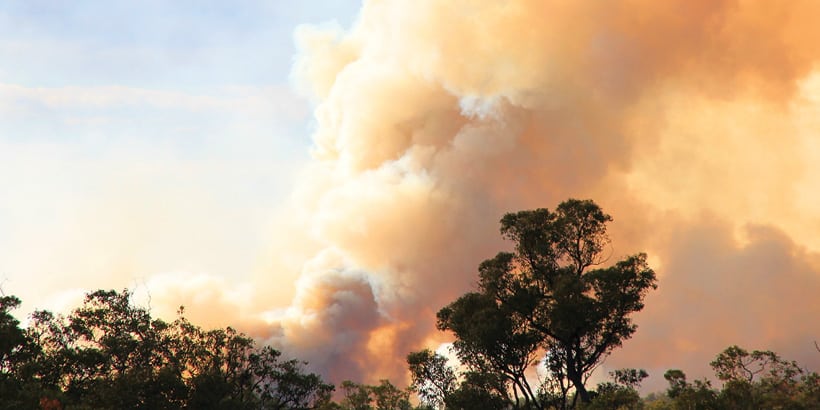
Fences to Build
April 9, 2020
A GP For Life
April 9, 2020FROM THE CEO
With the airfield closed and roads blocked, patients at Manning Rural Referral Hospital were marooned during the November bushfires. Dr Seshasayee Narasimhan explains how health professionals managed the crisis.
By late November 2019, approximately 1,650,000 hectares of land in NSW had been burnt – more than during the past three bushfire seasons combined.
At the time, the regions most affected were the Mid North Coast and Northern Tablelands, and catastrophic fire warnings were issued for Sydney, the Hunter, the Illawarra and Shoalhaven.
Dr Seshasayee Narasimhan received a text at midnight on 8 November from the RFS alerting him to the imminent fire dangers in Harrington. At that time, Taree was surrounded by five fires.
“It was very hot and there was ash flying everywhere,” says Dr Narasimhan, adding that scenes of nearby bushfires looked like something out of a movie.
After calling friends and family to warn them of the dangers, Dr Narasimhan’s thoughts turned to his patients in Taree and Manning Rural Referral Hospital. Dr Narasimhan provides non-invasive cardiology services in his private practice and consultation, echo and transoesophageal echo services in the public hospital.
In addition, he provides invasive cardiology services in the private sector in NSW and public sector in QLD and formally served as a visiting interventional cardiologist at the Gold Coast University Hospital.
At the time, Dr Narasimhan had four heart attack patients at Manning Rural Referral Hospital. With the airfield closed, air retrieval was impossible. As a result, patients were essentially marooned at Manning Hospital, which was surrounded by fires.
“They had to wait for clearance by the RFS before they could be transported to Newcastle which delayed their treatment. Thankfully, no patient became unstable – if they had deteriorated, they could have potentially had a bad outcome.”
Meanwhile, many of his outpatients were unable to come to appointments for consultations, echos, etc.
“Some patients had their planned procedures delayed. In addition, re-booking them was very challenging.”
He credits his staff for working tirelessly to meet all outstanding appointments prior to the practice’s closing date for Christmas.
He also says that during the worst of the crisis, hospital staff at Manning Rural Referral Hospital acted heroically to ensure patient care was not compromised.
“The hospital staff worked very hard in really trying conditions and managed to avert poor outcomes for our patients.
“They stayed back, volunteered and helped out where they could to get through the disaster. Once the acute period passed, there was emergency meetings where nurses presented issues and solutions on how we can put in place strategies to avoid any future disasters.”
According to Dr Narasimhan, the catastrophic situation highlighted the need to improve the hospital’s emergency services plan.
“It needs to be revised and modified to suit extreme situations where evacuation is not possible. For my patients, we were very fortunate that they did not become unstable.”
Going forward he suggests increased staffing, a helipad, upgrades to ICU, a delirium unit, a CCU and an on-site cardiac catheter lab would increase the hospital’s ability to function should similar disasters hit the area in the future.
On a personal level, that midnight text from the RFS sparked the beginning of several uncertain weeks for Dr Narasimhan, his wife Katrina, and his two children Zeke, 6, and Matilda, 3.
“Katrina and the children were confined to the house because of the danger of precipitating asthma. We hosted residents who were directly threatened with the destruction of their livestock and property.”
Originally from Madras, Dr Narasimhan completed his physician training in New Zealand and migrated to Australia in 2006, where he did general cardiology training at John Hunter Hospital, and his Interventional Cardiology training in New York and advanced PCI & Structural Interventional Cardiology in Canada.
The couple returned to Australia to start a family and decided to settle in Taree for several reasons.
“Katrina grew up partially in the country and reiterated the importance of addressing the lack of specialist availability in regional and rural Australia. We chose Taree as it was in the HNE network, had not had local cardiology support before and it was simply beautiful.”
Until the 2019 bushfire season, Dr Narasimhan had never experienced anything similar. While it’s been a stressful ordeal professionally and personally, he says his kids really stepped up.
“The children were fantastic. They understood the dangers of fires and were very keen to help. They were front and centre when we donated supplies to the local fire services.”

